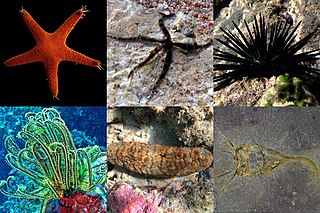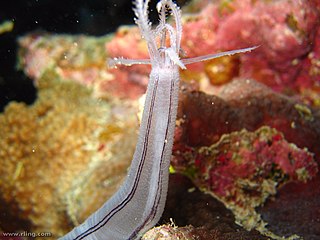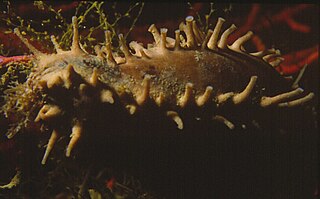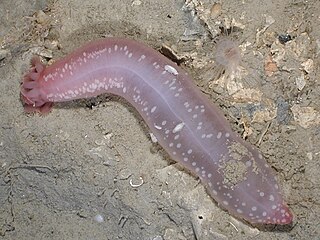
The Sipuncula or Sipunculida is a class containing about 162 species of unsegmented marine annelid worms. Sipuncula was once considered a phylum, but was demoted to a class of Annelida, based on recent molecular work.

An echinoderm is any member of the phylum Echinodermata. The adults are recognisable by their radial symmetry, and include starfish, brittle stars, sea urchins, sand dollars, and sea cucumbers, as well as the sea lilies or "stone lilies". Adult echinoderms are found on the sea bed at every ocean depth, from the intertidal zone to the abyssal zone. The phylum contains about 7,000 living species, making it the second-largest grouping of deuterostomes, after the chordates. Echinoderms are the largest entirely marine phylum. The first definitive echinoderms appeared near the start of the Cambrian.

Sea cucumbers are echinoderms from the class Holothuroidea. They are marine animals with a leathery skin and an elongated body containing a single, branched gonad. They are found on the sea floor worldwide. The number of known holothurian species worldwide is about 1,786, with the greatest number being in the Asia-Pacific region. Many of these are gathered for human consumption and some species are cultivated in aquaculture systems. The harvested product is variously referred to as trepang, namako, bêche-de-mer, or balate. Sea cucumbers serve a useful role in the marine ecosystem as they help recycle nutrients, breaking down detritus and other organic matter, after which bacteria can continue the decomposition process.

Apodida is an order of littoral to deep-sea, largely infaunal holothurians, sea cucumbers. This order comprises three families, 32 genera and about 270 known species, called apodids, "without feet".

Dendrochirotida are an order of sea cucumbers. Members of this order have branched tentacles and are suspension feeders. Examples include Thyonella and Cucumaria.

Holothuriida is an order of sea cucumbers. Taxa within the order Holothuriida were previously classified in the order Aspidochirotida, which was determined to be polyphyletic in 2017. Some taxa were also reclassified into the clades Synallactida and Persiculida.

The orange-footed sea cucumber is the largest sea cucumber in New England, United States. It is one of the most abundant and widespread species of holothurians within the North Atlantic Ocean and the Barents Sea (Russia), being most abundant along the eastern coast of North America.

Cucumaria miniata is a species of sea cucumber. It is commonly known as the orange sea cucumber or red sea cucumber due to its striking color. This northeast Pacific species is often found wedged in between rocks or crevices at the coast or on docks and can generally be identified by its orange bushy tentacles protruding above the substrate.

Synaptula lamperti is a species of sea cucumber in the family Synaptidae in the phylum Echinodermata, found on coral reefs in the Indo-Pacific region. The echinoderms are marine invertebrates and include the sea urchins, starfish and sea cucumbers. They are radially symmetric and have a water vascular system that operates by hydrostatic pressure, enabling them to move around by use of many suckers known as tube feet. Sea cucumbers are usually leathery, gherkin-shaped animals with a cluster of short tentacles at one end. They live on the sea bottom.

Caudinidae is a family of sea cucumbers, marine animals with elongated bodies, leathery skins and tentacles that are found on the sea floor.
Molpadiidae is a family of sea cucumbers, marine invertebrates with elongated bodies, leathery skins and tentacles that are found on or burrowing in the sea floor.

Holothuria forskali, the black sea cucumber or cotton-spinner, is a species of sea cucumber in the family Holothuriidae. It is found at shallow depths in the eastern Atlantic Ocean and the Mediterranean Sea. It was placed in the subgenus Panningothuria by Rowe in 1969 and is the typetaxon of the subgenus.

Holothuria scabra, or sandfish, is a species of sea cucumber in the family Holothuriidae. It was placed in the subgenus Metriatyla by Rowe in 1969 and is the type species of the subgenus. Sandfish are harvested and processed into "beche-de-mer" and eaten in China and other Pacific coastal communities.

Sclerodactyla briareus, commonly known as the hairy sea cucumber, is a species of marine invertebrate in the family Sclerodactylidae. It is found in shallow waters in the western Atlantic Ocean.

Euapta lappa, the beaded sea cucumber, is a species of sea cucumbers in the family Synaptidae in the phylum Echinodermata. It is found on coral reefs in the Caribbean region.

Ocnus planci is a species of sea cucumber in the family Cucumariidae. It is native to the north-eastern Atlantic Ocean.

Chiridotidae is a family of sea cucumbers found in the order Apodida. Within the family, there are 16 recognized genera all with different ranges of body types and functions. Sea cucumbers play a fundamental role in many marine ecosystems.

Paraleptopentacta elongata is a species of sea cucumber in the family Cucumariidae. It is found in the northeastern Atlantic Ocean and parts of the Mediterranean Sea. It is an infaunal species, occupying a burrow in the seabed, from which its anterior and posterior ends project.

Cucumaria vegae, also known as tiny black sea cucumber or northern tar spot, is a species of sea cucumber. It was first described to science by Johan Hjalmar Théel in 1886 reporting on the sea cucumber specimens brought back by the Challenger expedition. Among these was the type specimen for this species, which was collected at Bering Island.

Parastichopus regalis, also known as the royal sea cucumber, is a species of sea cucumber in the family Stichopodidae.



















